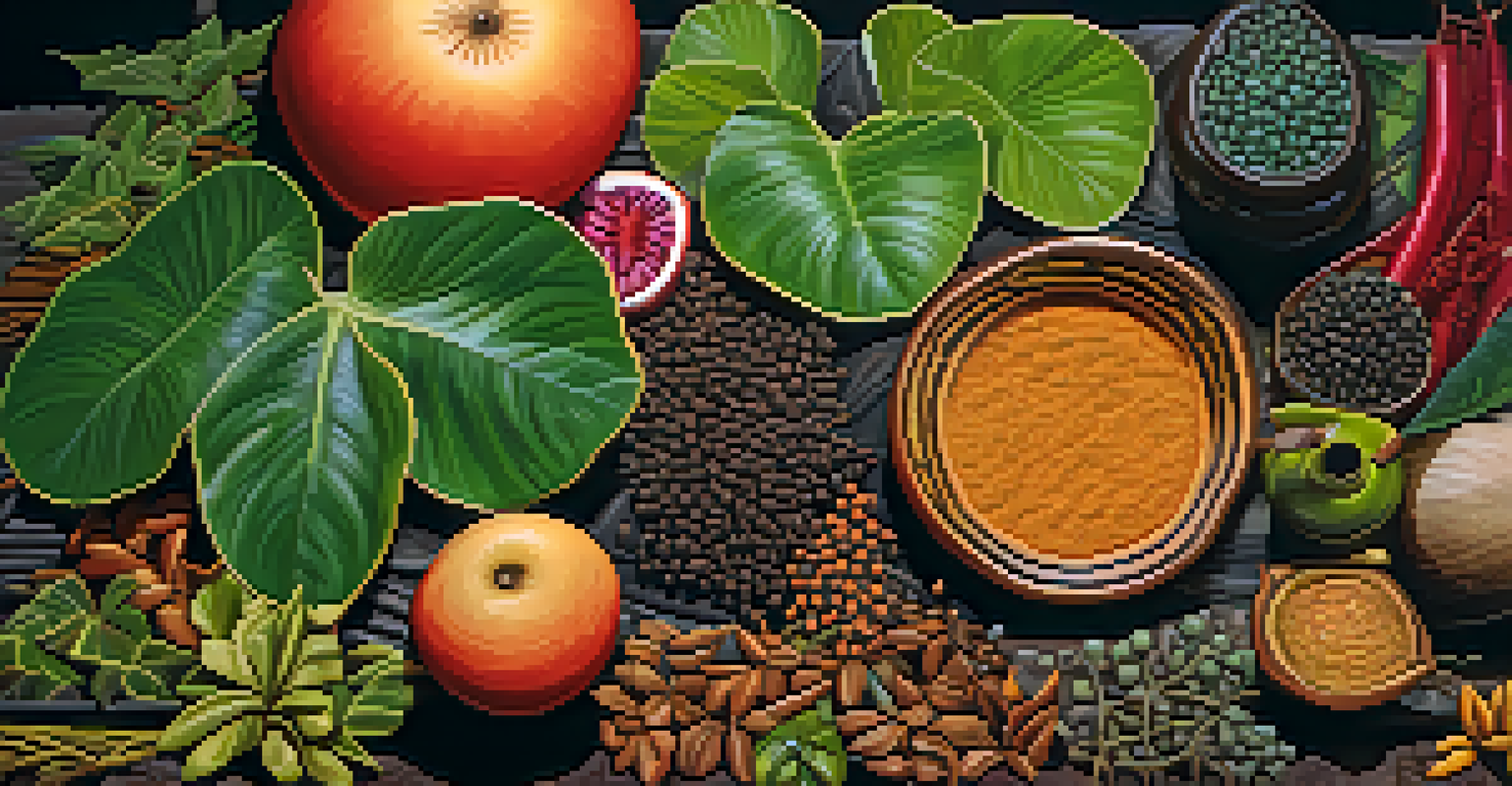Enhancing Somatic Awareness: Insights from Ayahuasca Use

Understanding Somatic Awareness and Its Importance
Somatic awareness refers to the conscious perception of bodily sensations and experiences. It allows individuals to connect with their physical selves, fostering a deeper understanding of emotions and thoughts. This awareness is essential for holistic well-being, as it can lead to improved mental clarity and emotional stability.
One does not become enlightened by imagining figures of light, but by making the darkness conscious.
Many people move through life disconnected from their bodies, often ignoring physical cues that signal stress or discomfort. Enhancing somatic awareness can help bridge this gap, encouraging a more mindful approach to living. For instance, someone might notice tension in their shoulders when stressed, prompting them to address the underlying issue rather than simply carrying on.
Practices like yoga, meditation, and breathwork can cultivate this awareness, but some seek deeper experiences through psychedelics, such as Ayahuasca. The use of this traditional plant medicine offers a unique avenue to explore and enhance somatic awareness, leading to profound insights about oneself.
What Is Ayahuasca and Its Historical Context?
Ayahuasca is a traditional Amazonian brew made from the Banisteriopsis caapi vine and other plant ingredients. It has been used for centuries by Indigenous cultures for spiritual and healing purposes. The brew contains DMT, a powerful hallucinogen, which can induce altered states of consciousness, allowing users to explore their inner worlds.

Historically, shamans or healers have guided ceremonies involving Ayahuasca, providing support and context for participants' experiences. This communal and ritualistic aspect can enhance the healing process, as individuals feel more connected to others and the natural world. The collective experience often leads to shared insights that can deepen one’s understanding of personal and communal issues.
Somatic Awareness Enhances Healing
Developing somatic awareness allows individuals to connect with their bodily sensations, leading to improved emotional understanding and healing.
Today, Ayahuasca has gained popularity beyond its traditional roots, attracting individuals seeking personal growth and healing. However, it’s essential to approach these experiences with respect and understanding of the cultural significance behind them.
The Connection Between Ayahuasca and Somatic Awareness
The experience of consuming Ayahuasca often leads to heightened somatic awareness. Users report being more attuned to their bodies, noticing sensations and emotions that may have been previously overlooked. This increased awareness can facilitate a deeper exploration of personal traumas and emotional blockages.
The body holds the score.
During an Ayahuasca ceremony, participants may encounter intense physical sensations, which can serve as gateways to emotional healing. For example, someone might feel a tightness in their chest that, upon exploration, reveals feelings of grief or loss. By addressing these sensations, individuals can work through their emotions in a safe and supportive environment.
This connection between body and mind is critical for holistic healing, as it allows individuals to integrate their emotional experiences with their physical being. The insights gained during these ceremonies can lead to lasting changes in how one interacts with their body and emotions.
Ayahuasca's Role in Trauma Healing and Integration
Many people seek Ayahuasca for its potential to heal trauma, both past and present. The brew can create a space for individuals to confront painful memories and emotions, facilitating a process of release and understanding. This can be especially beneficial for those who have experienced significant life challenges or loss.
The integration of these experiences post-ceremony is crucial. Participants often work with integration coaches or therapists to make sense of their Ayahuasca journey and apply the insights gained to their daily lives. This process helps solidify the connection between somatic awareness and emotional healing.
Ayahuasca's Role in Trauma Recovery
Ayahuasca provides a unique opportunity for individuals to confront and heal from their trauma through heightened bodily awareness and emotional exploration.
Additionally, sharing experiences with fellow participants can foster a sense of community and support, further enhancing the healing journey. By addressing trauma through the lens of somatic awareness, individuals can move toward a more empowered and integrated self.
Practical Techniques for Enhancing Somatic Awareness
While Ayahuasca can be a powerful tool for enhancing somatic awareness, there are accessible techniques anyone can practice. Mindfulness meditation, for instance, encourages individuals to tune into their breath and bodily sensations, fostering a deeper connection to the present moment. This practice can be done anywhere and requires no special preparation.
Another effective technique is body scanning, where individuals focus their attention on different parts of their body, noticing sensations, tension, or emotions. This simple exercise can reveal areas where one might be holding stress, promoting relaxation and awareness. Pairing these techniques with journaling can also deepen the exploration of one’s sensations and feelings.
Incorporating movement practices, such as dance or yoga, can also enhance somatic awareness. These activities encourage individuals to express themselves physically, helping to release pent-up emotions and foster a deeper understanding of their bodies.
Cautions and Considerations When Using Ayahuasca
As enticing as Ayahuasca may sound, it’s essential to approach its use with caution. Not everyone is a suitable candidate for Ayahuasca ceremonies, particularly those with certain mental health conditions or who are taking specific medications. Consulting with a healthcare professional is crucial before considering participation in such rituals.
Additionally, the setting and guidance during an Ayahuasca ceremony can significantly impact the experience. It’s vital to find reputable facilitators who understand the cultural context and can provide a safe environment. A supportive atmosphere can make all the difference in how individuals process their experiences.
Practical Techniques for Awareness
Accessible practices like mindfulness meditation and body scanning can significantly enhance somatic awareness, offering tools for personal growth.
Lastly, it’s important to recognize that while Ayahuasca can facilitate profound insights, the real work begins afterward. Integration and ongoing self-reflection are necessary to make the most of the revelations gained during the experience.
The Future of Somatic Awareness and Ayahuasca Practices
As interest in Ayahuasca continues to grow, so does the conversation around somatic awareness. Many are beginning to recognize the importance of integrating body awareness into their healing journeys, creating a bridge between traditional practices and modern wellness. This shift highlights a broader trend toward holistic approaches to mental and emotional health.
Emerging research is beginning to explore the benefits of psychedelics like Ayahuasca for mental health treatment. As stigma decreases, more individuals may seek these experiences as legitimate pathways to healing. This can potentially lead to a greater understanding of the connection between somatic awareness and emotional well-being.

Ultimately, the future of somatic awareness and Ayahuasca practices will likely involve a blend of traditional wisdom and contemporary therapeutic approaches. As more people embark on their journeys, the conversation will continue to evolve, fostering a greater appreciation for the profound connections between body, mind, and spirit.